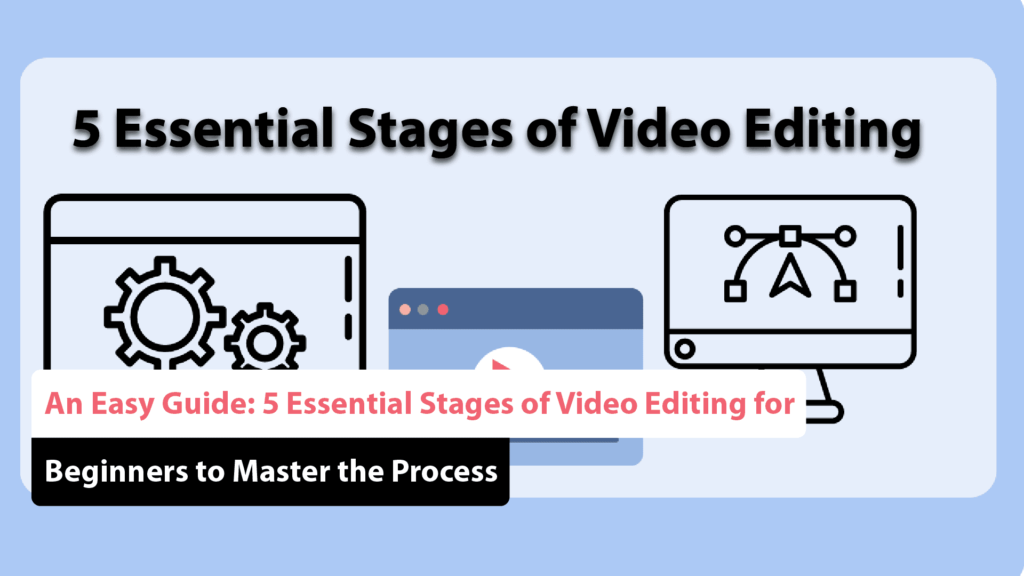An Easy Guide: 5 Essential Stages of Video Editing for Beginners to Master the Process
We can all agree that video and film production can be both tedious and chaotic: A filmmaker faces immense pressure, particularly when it comes to meticulously adhering to the various stages of video editing. Animotions Studio is excited to introduce our live-action video production services, which, believe it or not, present a greater challenge than creating a straightforward animated video. Coordinating shoot schedules, assembling the crew, and ensuring all equipment is in order can be daunting. Even a single disruption in this process can feel like navigating turbulent waters with no safe harbor in sight. However, there is one aspect of video production that remains consistent, straightforward, and systematic editing. In many cases, editing serves as a refuge from the frenzy of production, providing a moment to regroup assuming, of course, that the dependable 5-step process is followed. The editing phase allows filmmakers to refine their narratives, enhance visual storytelling, and ensure every frame resonates with the audience. It is where creativity meets precision, transforming raw footage into a polished final product. By adhering to a structured process, editors can maintain focus and clarity, allowing their artistic vision to shine through. Ultimately, mastering this editing journey is essential for delivering compelling videos that engage viewers and tell powerful stories. So, without further delay, let’s delve into the 5-step video editing process. What are The 5 Stages of Video Production? The 5 stages of video production encompass the entire process of creating a video, from initial concept to final distribution. Each stage is crucial for ensuring the project aligns with the creative vision and meets the intended goals. By understanding and executing these stages effectively, creators can enhance the quality and impact of their video content, resulting in a more engaging experience for the audience. The 5 Stages of Video Production: The 5 stages of video production include strategy and development, pre-production, production, and post-production. Each phase is meticulously designed to facilitate the planning and preparation for subsequent stages, ensuring a seamless production process. Understanding these stages is vital for achieving a high-quality video that effectively communicates its intended message and resonates with the audience. Let’s explore each phase in detail to understand what they involve. Stage 1: Strategy and Development: In this initial stage, the primary focus is to establish a clear strategy for the video if one is not already in place. It’s essential to take the time to define or reaffirm the video’s objectives, messaging, and guidelines for the content you plan to create. This stage is often overlooked, but laying a solid foundation is crucial for the rest of the production process. Ensuring that you, your team, and any partners or vendors understand the underlying strategy, goals, and key performance indicators (KPIs) will help streamline future planning phases. Stage 2: Pre-Production: During the pre-production phase, the content and goals outlined in the strategy become actionable. Here, you will establish budgets and the overall scope of the project, create scripts and storyboards, and develop a timeline for the subsequent production and post-production phases. This is also the stage where you’ll scout locations, select talent, and gather necessary equipment. Essentially, pre-production is dedicated to identifying everything that needs to be created or organized before filming begins. Stage 3: Production: The production phase is where all the planning from the strategy and pre-production stages comes to fruition, and the actual shooting begins. In this phase, you’ll set up locations and equipment, capture the footage as outlined in your storyboard or shot list, and have talent perform the script. This is the hands-on part of the process where all the elements come together to create the content needed for your final product. Stage 4: Post-Production: Once filming is complete, the project moves into post-production. This phase involves editing the video into its final form, where video footage and audio are refined and mixed. You may add music, voiceovers, and visual effects, along with titles, credits, and other text elements as needed. Essentially, post-production is where you transform the raw assets from the production phase into a polished final product, while also preparing for the distribution stage. Stage 5: Distribution: Ideally, you will have devised a distribution plan during the strategy or pre-production stages. This phase focuses on sharing your completed video with the world. Consider how your audience will access it will it be broadcast on television, shared on social media, or featured on your website? Whatever your distribution strategy, this is the time to put it into action and aim to capture the attention of your target audience. 5 Stages of the Video Editing Process: Start to Finish for Every Aspiring Creator While the video editing process may appear overwhelming at first, I assure you, that it’s far simpler than the production phase and can even be quite enjoyable. Once you’ve captured your footage, the real magic begins as you settle in front of your computer and focus your time on transforming those clips into a polished final product. This stage is where your creativity can truly shine, allowing you to create a narrative that engages and captivates your audience. Here are the five key steps involved in the video editing process: In these stages, you’ll transform raw clips into a cohesive story, enhancing pacing and flow. Each step plays a crucial role in ensuring the final product aligns with your creative vision. As you progress through these phases, you’ll find the process becoming more intuitive, allowing your storytelling to flourish. Moreover, effective editing can significantly create the emotional impact of your video, making it more relatable and memorable for viewers. This is where you can experiment with different techniques, effects, and transitions to enrich the visual experience. As you refine your project, remember that patience and practice are key each edit brings you closer to achieving your desired outcome. Now, let’s dive into each of these 5 stages of video editing in detail. Stage #1: Footage Logging Image Source: Motion Array At the outset, your main responsibility will be






